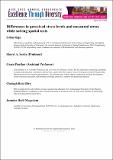| dc.contributor.author | Raju, Gibin | |
| dc.contributor.author | Sorby, Sheryl A. | |
| dc.contributor.author | Panther, Grace | |
| dc.contributor.author | Reid, Clodagh | |
| dc.contributor.author | Mogadam, Jasmine Haili | |
| dc.date.accessioned | 2022-12-02T10:35:36Z | |
| dc.date.available | 2022-12-02T10:35:36Z | |
| dc.date.copyright | 2022 | |
| dc.date.issued | 2022-08-26 | |
| dc.identifier.citation | Raju, G., & Sorby, S., & Panther, G., & Reid, C., & Mogadam, J. (2022, August), Differences in perceived stress levels and measured stress while solving spatial tests Paper presented at 2022 ASEE Annual Conference & Exposition, Minneapolis, MN, June 26th-29th. https://peer.asee.org/41582 | en_US |
| dc.identifier.uri | https://research.thea.ie/handle/20.500.12065/4327 | |
| dc.description.abstract | Many events, including tests, personal conflicts, and hard deadlines, may result in a high level of stress for both students and educational practitioners. For example, taking a test is particularly stressful for students who are less prepared and who may have limited knowledge of the subject. There is a dearth of literature regarding the stress levels, real or perceived, experienced by students while solving spatial tests. Advancements in micro-electromechanical systems have helped researchers in collecting physiological data with smart devices such as wristbands, chest bands, and armbands. In particular, wristbands have been widely recommended by researchers because they are easy to wear, easy to use, and “non-invasive,” since they are similar to watches or exercise tracking devices.
This paper aims to explore the differences in self-reported stress levels perceived by engineering students and their stress levels recorded by a wristband while solving spatial tasks. An Empatica E4 wristband sensor was used to collect multiple body signals including 3-axis acceleration signals, Electrodermal Activity (EDA) signal, heart rate, and body temperature. In particular, recorded EDA signals reveal information on emotional and cognitive state by measuring the electrical resistance of the skin. If a person is under stress or experiencing increased cognitive load, the skin conductance increases. To measure the perceived stress levels by the participants, a perceived cognitive load instrument scale was used. This study involved 143 undergraduate engineering students at two large public research universities. The study was conducted over two sessions. The first phase of the study was online with participants completing three spatial tests including the Mental Cutting Test (MCT), the Paper Folding Test (PFT), and the Surface Development Test (SDT). The perceived cognitive load instrument was administered after each spatial test. During the second phase of the study, 35 participants were selected based on their performance on the spatial tests to come in person and wear the wristband device while completing spatial and verbal analogy tests and solving six engineering mechanics problems. The same perceived stress scale was administered at the end of each of these tests/tasks. Data was analyzed and evaluated to determine how stress level, both perceived and measured, varied for high and low spatial visualizers while solving spatial tests. The result highlights that engineering students experience stress while solving spatial problems. Analysis indicated that there were no statistically significant differences between the high and low spatial visualizers. Limitations of the study are discussed at the end. | en_US |
| dc.format | PDF | en_US |
| dc.language.iso | eng | en_US |
| dc.publisher | ASEE | en_US |
| dc.relation.ispartof | 2022 ASEE Annual Conference & Exposition | en_US |
| dc.rights | Attribution-NonCommercial-NoDerivs 3.0 United States | * |
| dc.rights.uri | http://creativecommons.org/licenses/by-nc-nd/3.0/us/ | * |
| dc.subject | Stress levels | en_US |
| dc.subject | Spatial tests | en_US |
| dc.subject | Spatial skills | en_US |
| dc.subject | Engineering education | en_US |
| dc.subject | Technology education | en_US |
| dc.title | Differences in perceived stress levels and measured stress while solving spatial tests | en_US |
| dc.type | info:eu-repo/semantics/other | en_US |
| dc.conference.date | 2022-06-26 | |
| dc.conference.host | American Society for Engineering Education | en_US |
| dc.conference.location | Minneapolis, MN | en_US |
| dc.contributor.affiliation | Technological University of the Shannon: Midlands Midwest | en_US |
| dc.description.peerreview | yes | en_US |
| dc.identifier.orcid | https://orcid.org/0000-0002-8593-1730 | en_US |
| dc.rights.accessrights | info:eu-repo/semantics/openAccess | en_US |
| dc.subject.department | Department of Technology Education: TUS Midlands | en_US |
| dc.type.version | info:eu-repo/semantics/publishedVersion | en_US |


